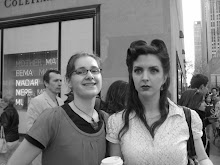For our last day in the land of Jordan we got to visit a number of places. Our first stop was at Kir - the capital of Moab. Here there was a Crusader castle located on the site. It was actually quite impressive, in that much of the castle was still covered having the ceiling intact. Kir is also the city that can connect to the Cisjordan through a land bridge in the Dead Sea when there is a drought. Moab can then get to the city of Masada, by taking this land bridge. From Kir we traveled to a look out spot near the Arnon canyon.
The Arnon canyon is the divider between Moab and the Medeba Plateau. The Medeba Plateau is the contested area between Israel and Moab, and also Ammon. These three kingdoms surround this piece of land and all claim ownership. The King's Highway also passes through the Arnon canyon, which means one has to choose to either zig-zag through the canyon or take the Desert Highway instead. Though the Desert Highway posses its own problems, like lack of ready resources and less protection against marauding 'desert pirates'. The Arnon canyon is really impressive, as any canyon this size would be. As we traveled down into it and up the other side you could get a glimpse of the Dead Sea, which this canyon drains into.
From the Arnon we went to Dibon, a city located just north of the canyon. At this site was found the Mesha Stele, which is a Moabite stone that relates the conflict between Moab and Israel. This city is also important, especially to Moab, because it is one of the few footholds Moab has in the Medeba plateau area. Moab consists of Senonian rock, which is associated with a shepherding lifestyle. You can see this emphasis on shepherding, especially for Moab, in the Bible where specifically states that even the king was a sheep herder (2 Kings 3).
From Dibon we went to see the Medeba Map located inside a very beautifully decorated church. The Medeba Map includes the area from Dan to Beersheba plus Egypt and Asia Minor. It is supposed to cover the major lands mentioned in the Bible. It is also eastern oriented and makes Jerusalem the largest and most detailed city on the map. This is due to the prominence given to Jerusalem in the Bible. It actually was a very interesting map, especially in how they represented different things. Though, it was hard to get a picture of the entire map since it spanned a good deal of the floor.
After we picked up our lunches we went to our last stop for Jordan, and for our Physical Settings class as a whole. We stopped at a nice look-out area on Mount Nebo. This is the mount that is mentioned at the end of Deuteronomy. God brings Moses up on this mount to give him a prophetic view of the land that the Israelites will (or at least were supposed to) possess. However, Moses himself is not allowed to enter the Promised Land due to his sin in the desert. We could get a nice view of the land from here, but no where near the view Moses had. Though, apparently it has been rumored that on really clear days people have thought that they saw the glimmers of the Mediterranean Sea. So who knows, maybe Moses was able to see the entire land or God may have miraculously shown him.
We also discussed here the theme of Deuteronomy being - remember. Remember what God has brought you through and what He has done. The question now is, will I remember what I learned about the land of the Bible when I leave? Will I choose to allow it to shape and deepen the way I read the Bible? Will choose to take what I learned and allow it to change me? I think we all should learn from Deuteronomy and never forget to remember, but also take it that a step further by choosing faith.
~Jennilee~P.S. I love you all and miss you. I can't believe this experience is almost over. We are all in crunch mode as our papers and finals are soon upon us. But as I realize that I will be leaving here, I think I have come to a better appreciation of this blessing. At first I must admit that I missed my home land rather strongly. However, God has helped me to appreciate Israel and all that Israel has to offer. I also will cherish many a long term friendship that would not have come to be without God directing my steps to this place. Well, Praise be to God, and may He have the glory through all that I have learned both inside and outside the classroom.
I can't wait to see you all.
Love you!



